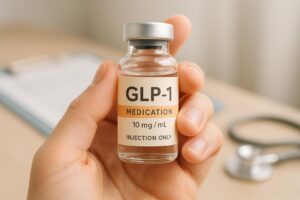Does GLP-1 Help With Weight Loss? Exploring the Science Behind GLP-1 Agonists

Every year, millions of individuals struggle with weight management and its associated health challenges. Interestingly, recent advancements in medical science have opened new avenues for effective weight loss strategies, specifically with the use of glucagon-like peptide-1 (GLP-1) receptor agonists. But how do these medications work, and do they really help with weight loss? In this blog post, we’ll dive deep into the world of GLP-1 agonists, exploring their mechanisms, benefits, and implications for weight loss.
Introduction
Did you know that obesity affects over 42% of adults in the United States? This alarming statistic highlights a significant public health challenge that continues to grow. Many individuals are turning to various methods for weight management, from lifestyle changes to medical interventions. Among these methods, GLP-1 receptor agonists, such as semaglutide and tirzepatide, are gaining attention for their potential to promote weight loss.
GLP-1 is a hormone naturally produced in the intestines that plays a crucial role in glucose metabolism and appetite regulation. When utilized therapeutically, GLP-1 agonists can mimic this hormone’s effects, leading to improved blood sugar control and reduced appetite—a dual benefit that makes them a powerful tool in the fight against obesity.
In this comprehensive guide, we will explore how GLP-1 agonists work, who they are designed for, potential side effects, and their overall effectiveness in promoting weight loss. By the end of this article, you’ll have a clear understanding of whether GLP-1 can be a suitable option for your weight loss journey.
Understanding GLP-1 and Its Role in Weight Loss
What is GLP-1?
GLP-1, or glucagon-like peptide-1, is a hormone produced in the L-cells of the intestines in response to food intake. It has several important functions in the body, including:
- Stimulating Insulin Secretion: GLP-1 promotes the release of insulin from the pancreas, which helps lower blood sugar levels after meals.
- Inhibiting Glucagon Release: It reduces the release of glucagon, a hormone that increases blood sugar levels, thereby maintaining better glucose control.
- Slowing Gastric Emptying: GLP-1 slows the emptying of the stomach, which prolongs the feeling of fullness after eating.
- Reducing Appetite: It acts on the brain to enhance feelings of satiety, leading to decreased food intake.
How Do GLP-1 Agonists Work?
GLP-1 receptor agonists are medications that mimic the action of natural GLP-1. By activating GLP-1 receptors in the body, they produce similar effects to those of the hormone itself. This results in:
- Increased Insulin Production: In response to meals, leading to better blood sugar control.
- Decreased Glucagon Release: Helping to prevent blood sugar spikes.
- Enhanced Satiety: By slowing gastric emptying and promoting fullness signals to the brain.
These combined actions contribute significantly to weight loss, making GLP-1 agonists a promising option for those struggling with obesity.
FDA-Approved GLP-1 Agonists for Weight Loss
Several GLP-1 receptor agonists are FDA-approved for weight management, including:
- Semaglutide (Wegovy, Ozempic)
- Tirzepatide (Mounjaro, Zepbound)
- Liraglutide (Saxenda)
These medications are typically prescribed at higher doses for weight loss compared to their diabetes treatment doses.
The Effectiveness of GLP-1 Agonists for Weight Loss
Clinical Evidence
Numerous clinical trials have demonstrated the effectiveness of GLP-1 receptor agonists in promoting weight loss. Studies show that individuals using these medications can achieve significant reductions in body weight, often losing between 10% to 15% of their body weight over a year or more. Some patients have reported weight losses exceeding 20% with consistent use.
For example, a pivotal clinical trial involving semaglutide showed that participants lost an average of 15% of their body weight after 68 weeks of treatment compared to a placebo group. This weight loss was accompanied by improvements in various metabolic parameters, such as lower blood pressure and improved cholesterol levels.
How Does Weight Loss Occur?
The weight loss associated with GLP-1 agonists can be attributed to several factors:
- Increased Satiety: Users often feel fuller after smaller meals, leading to reduced caloric intake.
- Reduced Cravings: Many individuals report fewer food cravings and less desire for unhealthy snacks.
- Behavioral Changes: The combination of pharmacological support and guidance from healthcare professionals can lead to healthier lifestyle changes, including improved diet and increased physical activity.
Who Can Benefit from GLP-1 Agonists?
Ideal Candidates
GLP-1 agonists are primarily recommended for individuals who:
- Are classified as having obesity (with a BMI of 30 or higher) or overweight (BMI of 25 or higher) with weight-related health issues.
- Have not achieved adequate weight loss through diet and exercise alone.
- Have type 2 diabetes and are seeking better blood sugar control along with weight loss.
Consultation and Assessment
Before starting treatment, individuals must undergo a thorough assessment. At TrimRx, we offer a free assessment quiz to determine eligibility for our personalized weight loss programs. This quiz helps us tailor a treatment plan that aligns with each individual’s unique needs and goals. If you’re interested in exploring your options, take our free assessment quiz here.
Potential Side Effects of GLP-1 Agonists
While GLP-1 agonists can be effective for weight loss, like any medication, they come with potential side effects. Some of the most common side effects include:
- Gastrointestinal Issues: Nausea, vomiting, diarrhea, and constipation are frequently reported, especially when starting the medication. These symptoms often improve over time as the body adjusts.
- Injection Site Reactions: Some patients may experience mild redness or itching at the injection site.
- Headaches and Fatigue: These can occur but are generally less common.
Serious Concerns
Though rare, there are serious side effects to be aware of, including:
- Pancreatitis: There have been reports of inflammation of the pancreas in some individuals taking GLP-1 agonists. It’s essential to seek medical attention if experiencing severe abdominal pain.
- Kidney Issues: Some patients may experience changes in kidney function, particularly those with pre-existing kidney conditions.
It’s crucial to have open discussions with healthcare providers about the potential risks and benefits before starting any medication, including GLP-1 agonists.
The Role of Support Supplements
While GLP-1 agonists can significantly aid in weight management, we at TrimRx also recognize the importance of comprehensive support throughout the weight loss journey. Our GLP-1 Daily Support and Weight Loss Boost supplements are designed to complement your weight loss efforts, providing essential nutrients and support for overall wellness.
You can explore these quick-access supplements and how they can benefit you by visiting the following links:
Conclusion
In conclusion, GLP-1 receptor agonists represent a promising option for individuals seeking to manage their weight effectively. By mimicking the action of the naturally occurring GLP-1 hormone, these medications help regulate appetite, increase feelings of fullness, and promote weight loss. With clinical evidence supporting their effectiveness and a range of FDA-approved options available, GLP-1 agonists can be a valuable tool in the fight against obesity.
However, it’s essential to approach weight loss holistically, combining medication with lifestyle changes and ongoing support. If you’re considering GLP-1 therapy, we encourage you to take our free assessment quiz to see if you qualify for our personalized weight loss program. Together, we can embark on a journey toward a healthier, happier you.
FAQ
How long does it take to see results with GLP-1 agonists?
Most individuals begin to see weight loss results within a few weeks of starting treatment. However, significant weight loss can take several months, typically around 3 to 6 months for substantial changes.
Are GLP-1 agonists safe for everyone?
GLP-1 agonists are generally safe for most individuals; however, they may not be suitable for those with specific medical conditions, such as a history of pancreatitis or certain gastrointestinal issues. Always consult with a healthcare provider before starting any new medication.
Can I use GLP-1 agonists if I don’t have diabetes?
Yes, several GLP-1 agonists are approved specifically for weight loss in individuals without diabetes. They can be beneficial for those classified as overweight or obese.
What should I do if I experience side effects?
If you experience side effects while taking a GLP-1 agonist, it’s crucial to discuss them with your healthcare provider. They can help manage the symptoms or adjust your treatment plan as necessary.
How can I get started with GLP-1 therapy?
To start your journey, we recommend taking our free assessment quiz to determine your eligibility for our personalized weight loss programs. You can find the quiz here.
By understanding GLP-1 agonists’ mechanisms and benefits, individuals can make informed decisions about their weight loss journey. Together, we can explore the best path toward achieving your health and wellness goals.

Transforming Lives, One Step at a Time
Keep reading
Tracking Progress With GLP-1: What To Measure
Learn which metrics to track on GLP‑1 therapy—weight, waist, blood sugar, lipids, side effects, and non‑scale wins—and how often to monitor them.
Fatigue Solutions for Ozempic and Wegovy Users
Hydration, protein-rich meals, light activity, and better sleep can reduce medication-related fatigue and help maintain energy during weight-loss treatment.
GLP-1 Medication Side Effect Checker
Worried about GLP-1 medication side effects? Use our free checker for Semaglutide, Liraglutide, and more to learn what to expect and stay informed!



